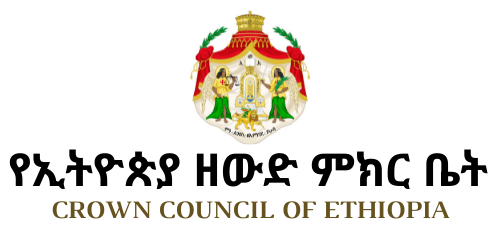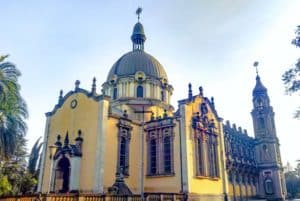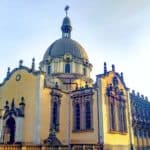One of Ethiopia’s great cultural and religious treasures of the modern era, the Holy Trinity Cathedral, in Addis Ababa, is in urgent need of repairs and restoration. The Cathedral — which houses the tombs of Her Imperial Majesty Empress Menem, His Imperial Majesty Emperor Amha Selassie I, Their Imperial Highnesses the Duke of Harar and Prince Sahle Selassie — is home to the Battle Standards of the Imperial Ethiopian forces, including the units which fought in the Korean War.
The Ethiopian Crown Council has taken up the cause of trying to raise funds for the urgent repairs, which are estimated to cost some 2.4-million birr (appr. $330,000), and is urging readers to send donations to the Haile Selassie Fund for Ethiopia’s Children, in the US, along with the form on page seven, earmarking the funds to be forwarded to the Cathedral authorities’ restoration fund. An address in Addis will be advised soon where donations can be made. Meanwhile, readers in Ethiopia should send their donations directly to the Cathedral, specifying that the money is to go to the restoration program.
The cornerstone for the great cathedral was laid by His Imperial Majesty Emperor Haile Selassie I in December 1931 (Western calendar; 1924 EC), only a year after his coronation as Emperor, and well before the Italian invasion. His Holiness the Patriarch, Abuna John the 18th of Alexandria, blessed the occasion.
Work on construction was suspended with the Italian invasion of 1935 (1928 EC), but resumed in 1941 with the liberation of the nation. The cathedral, which was inaugurated in 1944, was named “Holy Trinity” and dedicated to the memory of the patriots who died defending Ethiopia. The Emperor had taken a personal and constant rôle in overseeing the construction of Holy Trinity.
The cathedral has since witnessed the consecration of a number of archbishops and the ordination of many priests and deacons of the Ethiopian Orthodox Church.
Emperor Haile Selassie used the cathedral on public holidays, and members of the Imperial Family frequented it. Several of them were later laid to rest there.
The cathedral was enlarged in 1946, the second of three phases in the construction of what is now the completed Holy Trinity. The third and final phase was underway in 1964, adding an additional 500sq.m. of space. Today, this, the most modern and largest church in Ethiopia, is used for the major religious ceremonies of the country.
One of the great murals in Holy Trinity depicts Emperor Haile Selassie pleading for the liberation of Ethiopia at the League of Nations. Another mural, which takes a full wall, depicts “the progressive march of four modern Ethiopian emperors, Téwodros, Yohannes, Menelik II, and Haile Selassie I”, under the watchful gaze of the mounted figure of Saint George, Ethiopia’s patron saint.
A bronze plaque in the cathedral commemorates the collaboration of the British and Ethiopian armies in the liberation of the nation, and the battle ensigns of Ethiopian regiments, garlanded with their battle honors, hang from staffs in the walls.
Superb examples of silver and wooden processional and hand crosses in the traditional Ethiopian style, along with an extensive library, sacred vessels, pyxes and ceremonial umbrellas are among the treasures in Holy Trinity, while outside are the graves of many who died defending the country.
The beautiful cathedral now, however, is facing problems. Leakage in various parts of the roof is worsening, causing serious damage to the interior, including damage to some precious religious paintings and to the windows.
A meeting was called on May 27, 1995, to take preliminary steps to address the problem. The present Patriarch, His Holiness Abuna Paulos, was present and called for the faithful to fulfill their religious obligations by contributing their share to the restoration of the cathedral. A Fundraising Committee of 15 people was established to work within the country and abroad on the project.
An international contractor, EMC (Elmecon plc,), of the UK, was called in to make a complete study of the problems, and has filed a full report to the cathedral committee. The cost for repairing the roof, the most urgent part of the program, is estimated at 975,687 birr ($137,000 appr.).
“Holy Trinity represents the unity of modern Ethiopia,” the President of the Crown Council, Prince Ermias Sahle-Selassie Haile-Selassie said. “The cathedral is an important physical and spiritual home of the Nation. My Father, Grandmother and Uncles are entombed there, but so, too, are the bodies and spirits of those who have lived and died for the integrity and unity of our country.”
“We must now give willingly to preserve it.”








